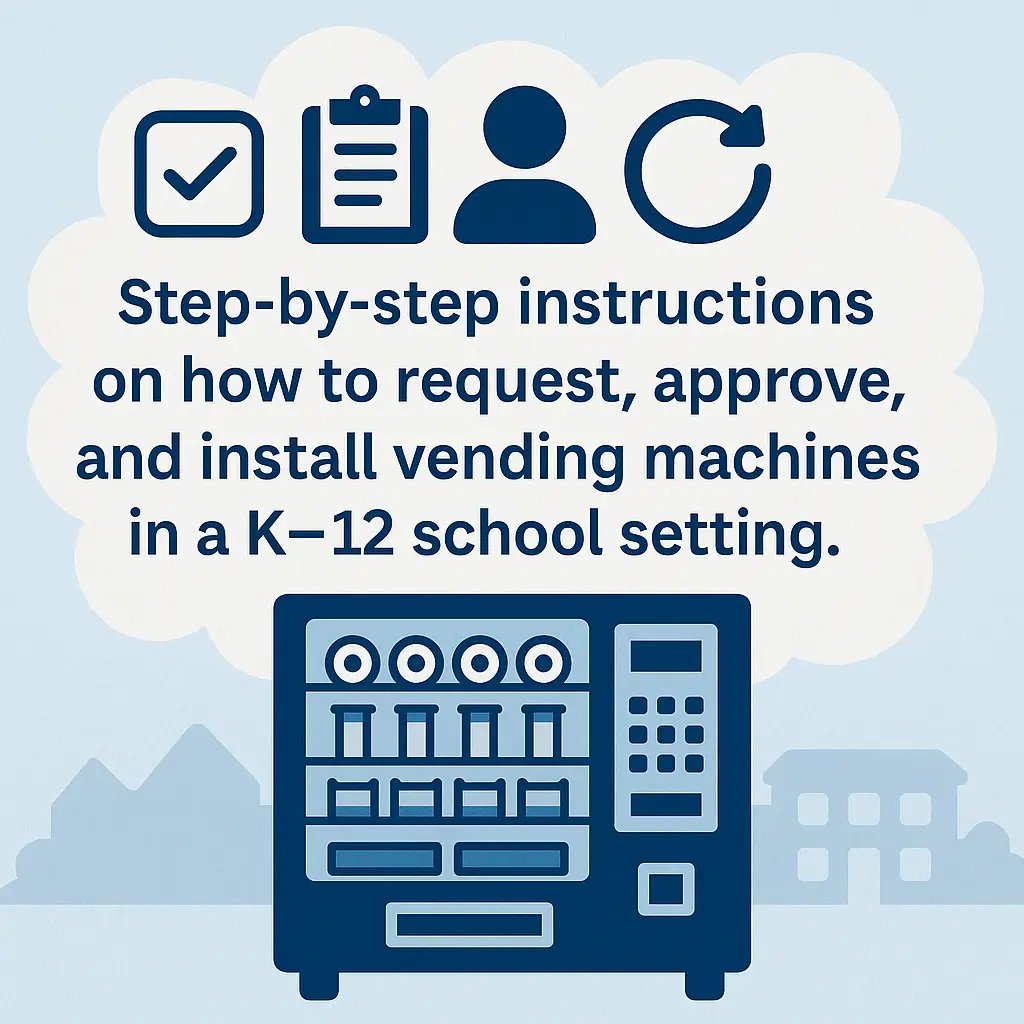How to Get Vending Machines in Your School
Step-by-step instructions on how to request, approve, and install vending machines in a K–12 school setting.
Back to Vending for Schools ResourcesStep-by-step instructions on how to request, approve, and install vending machines in a K–12 school setting.
Back to Vending for Schools ResourcesMost public K–12 schools are eligible for free vending installation. To get started, schools should identify a need, review district policies, and reach out to providers like Vending Exchange to ensure equipment, products, and service align with student needs and administrative requirements.
![]() Healthy vending options help meet school nutrition guidelines
Healthy vending options help meet school nutrition guidelines
![]() Machines with contactless pay are popular among students
Machines with contactless pay are popular among students
![]() Install process typically completed within one school week
Install process typically completed within one school week

Setting up vending machines in a school environment requires careful planning and approval. While the process may seem complex, following a structured approach can help ensure the vending setup meets your school’s needs and complies with district policy.
The first step is to identify the purpose of installing a vending machine. Whether to provide snacks, bottled water, or healthy alternatives to cafeteria food, understanding the goal clarifies what type of machine and items are appropriate. Next, check your district or school board’s vending policies. Some schools require certain nutritional standards or only permit machines in staff areas or specific time windows.
After reviewing guidelines, you’ll need to submit a vending request to the appropriate decision-makers—this may include your school principal, facilities manager, or district administrator. Be prepared to explain the benefits of vending, such as keeping students on campus, reducing visit frequency to external stores, or generating fundraising revenue for school programs.
Once approval is obtained, you can work with a vending provider to select the right equipment. combo machines that offer both snacks and cold drinks are popular in K–12 settings. Glass-front or smart vending machines are also gaining popularity due to their ability to provide healthier choices and accept contactless payments. Providers typically offer free installation and servicing as long as there is sufficient foot traffic.
It’s also worth considering placement and compliance with local food guidelines. The machine should be positioned in a visible, high-traffic area but away from potential distractions during classroom hours. For setups that meet more specific needs, such as apartment-style student housing or multi-use spaces, custom vending options may be worth exploring.
Final steps include setting a servicing schedule with your provider, monitoring sales data if accessible, and collecting any associated commissions for school use. Some schools also combine vending with other staff breakroom amenities, such as coffee delivery services, to create a full-service refreshments station.
If you're exploring vending options for your business, Vending Exchange can help simplify the process. Delivery, Installation and Equipment is provided at no cost to you - vendors provide the machines, keep them stocked, and handle all servicing. Whether you need a provider or full-service management, just fill out the form on this page to get started.
Begin by reviewing your school or district policies, then submit a formal proposal or request to your principal or administrative office. Make sure your plan covers objectives, product types, and vendor services.
Not always. Some districts limit vending to staff areas or have restrictions on operating hours and product types. Always check with your school board or district guidelines first.
Most schools focus on healthy options, including water, low-sugar drinks, baked snacks, and shelf-stable meals that meet USDA Smart Snacks standards.
Once approved, setup usually takes less than a week. Many vendors offer installation, delivery, and equipment at no cost if your school meets certain size or traffic requirements.
Your vending provider handles all machine servicing, restocking, and maintenance. Some schools opt for managed service agreements for consistent oversight.
Yes, most modern vending machines accept credit cards, mobile wallets, and contactless payments, making them ideal for student-friendly environments.
Your vending provider is responsible for timely repairs. Vending Exchange only works with vendors who respond quickly to service tickets and complaints.
Yes, some vendors offer commission options where a portion of vending revenue is returned to the school to support extracurricular or wellness programs.
In many districts, yes. You may need to present your plan to the school board or get sign-off from district-level leadership before moving forward.
Combo machines that offer both snacks and drinks are ideal for schools. They save space and provide variety while ensuring easy maintenance and stocking.